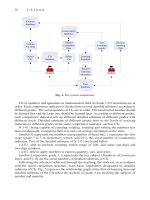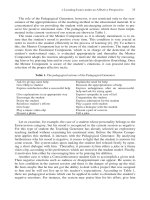Lecture Notes in Computer Science- P56 pptx
Bạn đang xem bản rút gọn của tài liệu. Xem và tải ngay bản đầy đủ của tài liệu tại đây (158.99 KB, 5 trang )
264 M. Spaniol et al.
15. Landry, B.M., Guzdial, M.: iTell: supporting retrospective storytelling with digital photos.
In: Proceedings of the 6th Conference on Designing interactive Systems DIS 2006, Uni-
versity Park, PA, USA, June 26-28, 2006, pp. 160–168. ACM, New York (2006)
16. Moreno-Ger, P., Blesius, C., Currier, P., Sierra, J.L., Fernández-Manjón, B.: Online Learn-
ing and Clinical Procedures: Rapid Development and Effective Deployment of Game-Like
Interactive Simulations. In: Pan, Z., Cheok, A.D., Müller, W., El Rhalibi, A. (eds.) Trans-
actions on Edutainment I. LNCS, vol. 5080, pp. 288–304. Springer, Heidelberg (2008)
17. Moreno-Ger, P., Martínez-Ortiz, I., Sierra, J.L., Fernández-Manjón, B.: A Content-Centric
Development Process Model. IEEE Computer 41(3), 24–30 (2008)
18. Moreno-Ger, P., Sierra, J.L., Martínez-Ortiz, I., Fernández-Manjón, B.: A Documental
Approach to Adventure Game Development. Science of Computer Programming 67(1), 3–
31 (2007)
19. Overmars, M.: Teaching Computer Science through Game Design. IEEE Computer 37(4),
81–83 (2004)
20. Perret, R., Borges, M.R.S., Santoro, F.M.: Applying Group Storytelling in Knowledge
Management. In: de Vreede, G J., Guerrero, L.A., Marín Raventós, G. (eds.) CRIWG
2004. LNCS, vol. 3198, pp. 34–41. Springer, Heidelberg (2004)
21. Sharda, N.: Movement Oriented Design: A New Paradigm for Multimedia Design. Inter-
national Journal of Lateral Computing (IJLC) 1(1), 7–14 (2005)
22. Spaniol, M., Klamma, R., Sharda, N., Jarke, M.: Web-Based Learning with Non-linear
Multimedia Stories. In: Liu, W., Li, Q., Lau, R. (eds.) ICWL 2006. LNCS, vol. 4181, pp.
249–263. Springer, Heidelberg (2006)
23. Steiner, K.E., Moher, T.G.: Graphic StoryWriter: an interactive environment for emergent
storytelling. In: Bauersfeld, P., Bennett, J., Lynch, G. (eds.) Proceedings of the SIGCHI
Conference on Human Factors in Computing Systems CHI 1992, Monterey, CA, pp. 357–
364. ACM, New York (1992)
24. Schäfer, L., Valle, C., Prinz, W.: Group storytelling for team awareness and entertainment.
In: Proceedings of the Third Nordic Conference on Human-Computer interaction Nordi-
CHI 2004, Tampere, Finland, vol. 82, pp. 441–444. ACM, New York (2004)
25. Weinberger, A.: Scripts for computer-supported collaborative learning effects of social
and epistemic cooperation scripts on collaborative knowledge construction. Dissertation,
Ludwig-Maximilians-University, Munich (2003)
F. Li et al. (Eds.): ICWL 2008, LNCS 5145, pp. 265–274, 2008.
© Springer-Verlag Berlin Heidelberg 2008
Three Layered Thinking Model for Designing Web-Based
Educational Games
Fong-Ling Fu
1
and Sheng-Chin Yu
2
1
Department of Management Information Systems, National Cheng-chi University,
Taipei 11605, Taiwan
2
Department of Information Management, Tung-Nan University,
Taipei 22202, Taiwan
Abstract. With the rapid development of the Internet and multimedia technolo-
gies, it has become feasible for educators to produce Web-based educational
games. However, challenges remain in terms of how to create content that en-
sures effective learning environments for different types of knowledge under a
limited budget. Thus, this paper presents a three layered model of game design
that integrates game goals within the curriculum and game design. The model
stresses the importance of decreasing the task complexity and increasing the
four flow factors: skill, challenge, concentration and pleasure. This model has
been applied to an experimental study in which three games were empirically
designed to test its practical usefulness. Findings indicated that the integrated
quality of a Web-based game encourages the learner’s engagement. Since Web-
based educational games are at an early stage of development, this model prom-
ises to be a useful tool for all phase of educational game design.
Keywords: Web-based game, educational game design, game design frame-
work, educational game evaluation.
1 Introduction
As the popularity of Web-based learning has surged, the development of Web-based
educational games has attracted instructors and developers due to these games’ ability
to appeal to the "e-generation" of learners who have grown up with computer games
[4]. However, there are two challenges in developing game-based learning materials
for education. Firstly, the development of games, compared to other Web-based learn-
ing materials, is usually more cost-consuming and presents greater technical obstacles
for the developers [11]. Secondly, compared to the leisured-based computer games,
the development of skill-based educational gaming has one more challenge: achieving
the goal of knowledge enhancement [5].
There are few studies which have guided the effective analysis and design phase on
development of Web-based educational games. According to experience theory,
game-based learning is considered to be a process that is based on adding new experi-
ences to old ones. Therefore, to develop game-based courseware, one must not only
consider the process of how the teachers’ constructed their curriculum, but also the
266 F L. Fu and S C. Yu
learners’ viewpoint on learning motives and flow. The main purpose of this study is to
prompt a useful model that provides comprehensive considerations on design proc-
esses of Web-based educational games to motive the players’ flows.
2 Perspectives on Web-Based Educational Games
Games are deeply engaging, visually dynamic, rapidly paced, effective tools for ex-
posing students to knowledge [12]. Undoubtedly, they will be the key technologies
use in the next-generation of educational tools in Web-based learning [4]. Improved
technology – namely FLASH-like multi-media development tools – make the job of
creating Web-based games much easier than before. They more efficiently increase
the players’ experience than any other type of material because the interactive immer-
sion component has already been strongly developed for the players [7]. However, a
good game-based educational material design is very complicated work; it should take
into account the interactions from four perspectives: (1) the particular context in
which learning takes place; (2) the characteristics of learners, (3) the internal repre-
sentational world of the game, and (4) pedagogic consideration [5]. We discuss these
perspectives below:
2.1 Pedagogic Considerations in Web-Based Educational Games
Pedagogic considerations include curricula objectives, pedagogic approach, learning
activities, and the corresponding learning outcomes [5]. Computer games provide a
learning-centered environment [12]. Learning is no longer a process of knowledge
transfer from the expert to the novice. Instead, the learning process takes place natu-
rally in the virtual world where players engage in the games. [13]. According to expe-
riential theory on game-based learning, learners construct the knowledge themselves
by interacting with the environment.
Table 1. Font sizes of headings. Table captions should always be positioned above the tables.
level Knowledge
taxonomy
Possible game styles
competence Possible game style
knowledge Game show competition, Flashcard type game, etc.
comprehension Simulation game
application Adventure games
analysis Role playing games, Detective games
synthesis Strategy games
Low
High
evaluation No games suitable
Bloom identified six levels of knowledge within the cognitive domain, from the
simple recall or recognition of facts, at the lowest level, to increasingly more complex
and abstract mental levels, with the highest order classified as evaluation. The taxon-
omy provided a useful structure that the teachers would be able to apply appropriate
Three Layered Thinking Model for Designing Web-Based Educational Games 267
strategies in their test questions [2]. In Table 1 we try to combine the possible games
styles suggested by Prensky [12] with Bloom’s taxonomy of knowledge.
Siang & Rao [13] suggested seven levels in a hierarchy needs that game players
demonstrate. At the bottom level, players are seeking information to understand the
rules of game. Then they need to know how to gain control over the game. After that,
they will expect more challenges (to meet esteem needs). The subsequent aesthetic
need involves players demand for good graphics and visual effects, appropriate music,
sound effects, and so forth. In game-playing, the aesthetic need is a higher ranking
need than esteem needs. Therefore, a good game should be sufficiently challenging
and match the player’s skill levels [15]. Game players experience flow, or addiction to
the game, only when the challenges offered match his/her skill [8]. The player per-
forms the learning activities required by the games and focuses on playing in order to
achieve the required learning outcomes [5].
A framework of pleasure by the anthropologist Lionel Tiger consists of four types
of pleasure that motivate usage: physiological, social, psychological and ideological
[1]. Physiological pleasure is derived from the sensory organs. It consists of pleasure
connected with touch, taste, and smell as well as feelings of sexual and sensual pleas-
ure. Social pleasure is derived from the company of others, such as having a conver-
sation or being part of a group. Psychological pleasure is gained from accomplishing
a task. Ideological pleasure is derived from the user’s perception of the importance of
the task itself. Ideological pleasure is only experienced by students taking important
courses that are perceived to be highly difficult [6].
The main purpose of educational game is to enhance players’ skills or knowledge.
Game players in Web-based learning can easily obtain physiological pleasure through
animations, sounds and other stimuli provided by the multimedia. The instructors who
design the game with pedagogy should consider the players pleasure and their hierar-
chy needs which are satisfied by the context of the online multimedia learning
platform.
2.2 Characteristics of University Students/Learners/Game Players
The new learning style of young people today demands a quick and enjoyable ap-
proach to learning [12]. The “new vs. old” tensions are: twitch speed vs. conventional
speed, parallel processing vs. linear, graphics first vs. text first, random access vs. step
by step, connected vs. stand alone, active vs. passive, play vs. work, payoff vs.
patience, fantasy vs. reality, and technology as friend vs. technology as foe [10].
Therefore, game based e-learning should match the preference of the e-generation of
university students. They are considered to have sufficient skills and background to
use the Internet as well as play digital games.
2.3 Context
The context considerations in educational game design include the physical environ-
ment, equipment, technical support personnel, and so forth [3, 5]. At the point of
technical view point, the FLASH-like software provides a cheap and easy way to
develop Web-based educational games. The large bandwidth of Internet accessible in
universities also provides an environment conducive to Web-based educational
268 F L. Fu and S C. Yu
games. At the knowledge delivery process view point, the context must provide ena-
bling factors to support student learning [5].
2.4 Internal Representational World of the Game Program Code
Issues regarding the mode of representation include choosing the appropriate tool and
content supporting learning activities that match the level needed for fidelity, immer-
sion, and realism [3]. The criterion of concentration implies that games should
provide stimuli that quickly grab the players’ attention and maintain their focus
throughout the game [15]. Interfaces such as tutorials, online support, and feedback
are important to a game’s usability [15]. Players should be able to start playing the
game without reading the user’s manual. They should receive feedback on their pro-
gress toward their goals. Multimedia presentations encourage learners to engage in
active learning by making mental connections between the story and structure of the
problems. In accordance with the complexity of the game’s storyline, the game can be
labeled as well-structured or ill-structured. The importance of the storyline depends
on the complexity of the game. Generally, the more complex the game is, the more
important the storyline tends to be [8].
Video games not only present problem solving activities and storylines but also of-
fer an effective internal representation that reinforces the players’ augmentation skills
in reading visual images, thinking, rule-discovery, language development, and trian-
gulating divided attention. By mapping out possible gaming styles and curriculum
content, learners can enjoy various learning activities while at the same time being
entertained [12]. For example, facts can be presented through game show competi-
tions, flashcard-type games, or action games; skills can be trained through persistent
state games, role-playing games, adventure games, or detective games; judgment
skills can be cultivated by role-playing games, multiplayer interaction adventure
games, or strategy games.
3 The Three Layered Thinking Model of Game Design
Since the steps of designing a useful educational game are too complicated to be ex-
plicated through a cognitive process, we developed a three layered matrix model to
analyze the stages of the design process (Fig. 1). The tasks of game design include
determining the game style, game task, and game interface. But how to determine
should base on the curriculum gaol. Thus, on the pedagogic level, the curriculum
goals need to be translated into game goals. The players’ previous skills and the
knowledge enhanced also require included [5]. The criterion for selecting the game
style is whether these styles match the goals of the game. The purpose of the game’s
tasks is to enhance the players’ knowledge and skills through the provision of chal-
lenges. Game players in a Web-based learning environment obtain physiological
pleasure from the multimedia material [1]. Meanwhile their psychological pleasure is
gained from overcoming the challenges in the learning games. Good interface design
helps players concentrate on the game. Learners perform the learning activities in the
games in order to achieve the required learning outcomes while focusing upon play-
ing [5]. Therefore, the achievements on game play can be concluded as pleasure,
challenge, skill enhance and concentration.









